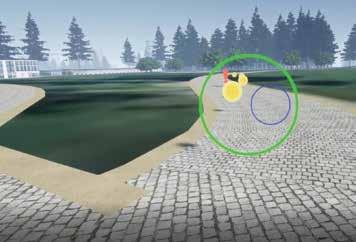
6 minute read
Mini Feature
PROTOTYPE ARTIFICIALLY INTELLIGENT POWER WHEELCHAIR TRAINING SYSTEM DEVELOPED AT WESTERN MICHIGAN UNIVERSITY
Written by: RICHARD MEYER, BS, MS, PHD
A prototype power wheelchair training system called Virtual Expert System drive (VESdrive) that combines artificial intelligence (AI), virtual reality, and a physical wheelchair has been developed at Western Michigan University by Richard Meyer from the Department of Mechanical and Aerospace Engineering and his student team comprised of Irene Kahvazadeh (Computer Science), Kira Hamelink (Engineering Design, Manufacturing and Management Systems), and Sindhu Vydyula (Mechanical Engineering). The prototype training system includes a foldable power wheelchair, high resolution virtual reality headset, control computer with custom software, electronic interface for communication between the wheelchair joystick and control computer, and roller stands that allow the power wheelchair’s drive wheels to turn while the wheelchair remains stationary.
The control computer executes custom software that provides many unique features to the training experience. First, it generates one of three VR environments for training: a mid-century home unmodified for wheelchair use; a modern office with cubicles, conference rooms and lobby; and a large open park with paved trails that have elevation changes.
Second, AI implemented in the software provides guidance to the user in the form of a goal circle the user is trying to match with a target circle. The goal circle represents the power wheelchair speed and direction of an AI-based expert user, i.e., a virtual expert. The user’s target circle changes direction and size relative to the goal circle to indicate the user’s deviation from the AI-based expert’s heading and speed, respectively. The AI simulates the actions learned from real human power wheelchair users.
Third, each VR environment provides a series of coins spaced out to pick up by driving through them in order to guide users from an initial starting point to a final ending point goal. For example, in the home environment, the user is tasked with moving from the living room in the front of the home to a bedroom in the back of the home, finishing next to a bed. The collection of the coins guides the user and is accompanied by video game noise to add excitement and make the training exercise fun.
Fourth, the custom software monitors collisions between the power wheelchair and any objects, for example, furniture, walls, trees, etc., and adjusts the power wheelchair’s maximum forward speed and maximum turning speed. If the user is often colliding with objects, the speed is gradually lowered until the number of collisions decreases over a set time period or the minimum allowable speeds are reached. If the speeds are currently at lowered values and collisions do not occur over a set period of time, the speeds are gradually increased back to the maximum allowable values.
At the end of the training exercise, these maximum values are output and can be implemented in the user’s power wheelchair as limits that reflect their current safe driving abilities.
A typical training session starts with the selection of the VR environment and an environment specific training scenario, such as navigating from the office lobby to the conference room, Next, the user puts on the VR headset and the scenario begins. They are then presented with the environment, coins nearby to start collecting, their target circle, and the AI virtual expert’s goal circle.



The user starts driving the power wheelchair using the standard joystick. These signals are sent to the computer and joystick use is reflected in the change in orientation and speed of the wheelchair in the virtual environment. If a collision preventing power wheelchair motion is detected in the VR environment, then the real-world wheelchair wheel motion is also stopped with the computer sending the appropriate stop command to the power wheelchair drive system. The user is presented with simulated visual (the VR) feedback and real world tactile and auditory feedback via the motions and sounds caused by the power wheelchair’s wheels turning in place while remaining safely on the roller stands.
The user trains in the VR environment until the scenario goal is reached or the training administrator stops the simulation. Data over time such as joystick commands, speed, direction, collision information, and more is then saved for review and additional data analysis.
The VESdrive provides an AI virtual expert based, fun, and consistent and repeatable training experience.
VESdrive is designed to be very flexible in VR environment scenario creation, taking only minutes, to ease test scenario development. The development team is seeking to further mature the product using patient and therapist feedback. Development of the VESdrive to
date was made possible with grants from the Western Michigan University Technology Development Fund and Michigan Economic Development Corporation University Early-Stage Proof of Concept Fund (ADVANCE).
CONTACT THE AUTHOR
Richard may be reached at RICHARD.MEYER@WMICH.EDU


